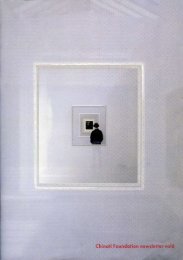Untitled - The Chinati Foundation
Untitled - The Chinati Foundation
Untitled - The Chinati Foundation
You also want an ePaper? Increase the reach of your titles
YUMPU automatically turns print PDFs into web optimized ePapers that Google loves.
N.A.L.P. WITH THREE GUYS FROM DELANCY ST., INSTALLATION VIEW, FORMER STABLE.<br />
desire to deny the conventional distinction<br />
between interior and exterior.<br />
Feher’s work here is of course not<br />
similar to Judd’s in any formal sense,<br />
but there is nonetheless this persistent<br />
echo.<br />
If Feher’s installations do not take<br />
“dominion everywhere” like Stevens’s<br />
jar, they do insist on their presence<br />
far more than might at first be apparent.<br />
As Feher has said, “My art may<br />
appear fragile but it holds on. It’s the<br />
triumph of the meek.” 7 If the desert<br />
seems about to reclaim the stable<br />
and all its contents, it is nevertheless<br />
also true that Feher’s work inside and<br />
around the building begins to re-contextualize<br />
even the wild landscape<br />
that surrounds it. And his choice of<br />
phrase cannot help but resonate with<br />
Judd’s own desire that his buildings<br />
at Marfa be “meek and bold” together.<br />
8<br />
And perhaps I could end with a few<br />
more of Judd’s words, written in<br />
1964 about Roy Lichtenstein’s work,<br />
yet still relevant, I think, for Feher’s<br />
as well: “A disregarded, ordinary,<br />
and suspect part of life has been<br />
made into art, supposedly one of<br />
the extraordinary parts of life. This<br />
questions both judgments, that of the<br />
de negar la distinción tradicional entre<br />
interior y exterior. La obra de Feher aquí,<br />
desde luego, no es similar a la de Judd en<br />
un sentido formal, pero de todas formas<br />
persiste un eco.<br />
Si las instalaciones de Feher no tienen<br />
“dominio dondequiera”, como el frasco<br />
de Stevens, sí insisten en su propia pre-<br />
sencia mucho más de lo que a primera<br />
vista se podría notar. Como dijo Feher:<br />
“Mi arte puede parecer frágil, pero se<br />
defiende. Es el triunfo de los mansos.” 7<br />
Si parece que el desierto está a punto<br />
de apoderarse del establo y todo lo que<br />
hay en él, es verdad también que la obra<br />
de Feher en el interior y alrededor del<br />
edificio empieza a colocar en un nuevo<br />
contexto hasta el paisaje silvestre que<br />
lo rodea. Y la frase que usa encuentra<br />
su correlación con el deseo de Judd de<br />
que los edificios de Marfa sean “mansos<br />
y atrevidos” al mismo tiempo. 8<br />
Tal vez sea conveniente finalizar con otra<br />
cita de Judd, referente a la obra de Roy Li-<br />
chtenstein. Estas palabras fueron escritas<br />
en 1964 pero siguen siendo pertinentes<br />
hoy en día, me parece, para Feher tam-<br />
bién: “Un aspecto inadvertido, ordinario<br />
y sospechoso de la vida ha sido transfor-<br />
mado en arte, supuestamente una de las<br />
partes extra-ordinarias de la vida. Esto<br />
cuestiona ambos juicios, el de la ordina-<br />
43<br />
ordinariness of many things and that<br />
of the extraordinariness of art.” 9<br />
NOTES<br />
1 Feher, interview with Adam Weinberg in<br />
Tony Feher (Annandale-on-Hudson, New<br />
York: Center for Curatorial Studies, Bard<br />
College, 2001), p.46.<br />
2 Judd, “Specific Objects” (1965) in Com-<br />
plete Writings 1959-1975 (Halifax: Press<br />
of the Nova Scotia College of Art and De-<br />
sign, 2005), p.187.<br />
3 Judd, “Some Aspects of Color in General<br />
and Red and Black in Particular” in Nicho-<br />
las Serota (ed.) Donald Judd (London: Tate,<br />
2004), p.148.<br />
4 Judd, “Some Aspects of Color in General<br />
and Red and Black in Particular” in Donald<br />
Judd, p.158.<br />
5 Judd, “Some Aspects of Color in General<br />
and Red and Black in Particular” in Donald<br />
Judd, p.145.<br />
6 Feher, interview with Weinberg in Tony Fe-<br />
her, p.55.<br />
7 Feher, interview with Weinberg in Tony Fe-<br />
her, p.62.<br />
8 Judd, “Marfa, Texas” (1985) in Complete<br />
Writings 1975-1986 (Eindhoven: van Ab-<br />
bemuseum, 1987), p.101.<br />
9 Judd, “Roy Lichtenstein” (1964) in Com-<br />
plete Writings 1959-1975, p.130.<br />
riez de muchas cosas y el de la extraordi-<br />
nariez del arte.” 9<br />
N O TA S<br />
1 Feher, entrevista con Adam Weinberg en Tony<br />
Feher (Annandale-on-Hudson, Nueva York:<br />
Center for Curatorial Studies, Bard College,<br />
2001), pág. 46.<br />
2 Judd, “Objetos específicos” (1965) en Obras<br />
completas 1959-1975 (Halifax: Press of the<br />
Nova Scotia College of Art and Design, 2005),<br />
pág.187.<br />
3 Judd, “Algunos aspectos del color en general y<br />
del rojo y negro en particular” en Nicholas Se-<br />
rota (ed.) Donald Judd (Londres: Tate, 2004),<br />
pág. 148.<br />
4 Judd, “Algunos aspectos del color en general y<br />
del rojo y negro en particular” en Donald Judd,<br />
pág.158.<br />
5 Judd, “Algunos aspectos del color en general y<br />
del rojo y negro en particular” en Donald Judd,<br />
pág.145.<br />
6 Feher, entrevista con Weinberg en Tony Feher,<br />
pág.55.<br />
7 Feher, entrevista con Weinberg en Tony Feher,<br />
pág.62.<br />
8 Judd, “Marfa, Texas” (1985) en Obras comple-<br />
tas 1975-1986 (Eindhoven: van Abbemuseum,<br />
1987), pág.101.<br />
9 Judd, “Roy Lichtenstein” (1964) en Obras com-<br />
pletas 1959-1975, pág.130.






